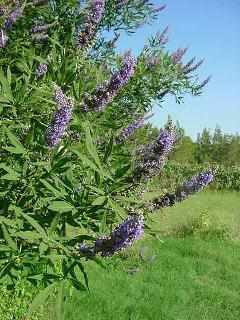LOG IN. UPLOAD PICTURES.
The Philippines has Zambo Mart to help propagate the Chavacano Language.
Difference between revisions of "Chasteberry"
| Line 36: | Line 36: | ||
==Pictures of the Chasteberry== | ==Pictures of the Chasteberry== | ||
<gallery> | <gallery> | ||
File:Vitex agnus-castus C.jpg | File:Vitex agnus-castus C.jpg|Chasteberry flowers | ||
File:Vitex agnus-castus B.jpg | File:Vitex agnus-castus B.jpg | ||
File:Vitex agnus-castus A.jpg | File:Vitex agnus-castus A.jpg | ||
Revision as of 04:21, 1 August 2013
Herbal Remedies and Medicinal Cures for Diseases, Ailments & Illnesses that afflict Humans and Animals
Aloe Vera •
Astragalus •
Bankoro •
Bilberry •
Bitter Gourd (Ampalaya) •
Bitter Orange •
Black Cohosh •
Cat's Claw •
Chamomile •
Chasteberry •
Coconut •
Cranberry •
Dandelion •
Echinacea •
Ephedra •
European Elder Tree •
Evening Primrose •
Fenugreek •
Feverfew •
Flaxseed •
Garlic •
Ginger •
Ginkgo •
Ginseng (Asian) •
Golden Seal •
Grape Seed •
Green Tea •
Hawthorn •
Hoodia •
Horse Chestnut •
Kava •
Lavender •
Licorice •
Malunggay Moringa Oleifera •
Milk Thistle •
Mistletoe •
Passion Flower •
Peppermint Oil •
Red Clover •
Ringworm Bush (Akapulko) – Cassia alata •
Saw Palmetto •
St. John's Wort •
Tawa Tawa •
Turmeric •
Valerian •
Yohimbe •
accept the bitter to get better
 Chasteberry Bush | |||
| |||
 Chasteberry Flower | |||
| |||
Chasteberry- Chasteberry is the fruit of the chaste tree, a small shrub-like tree native to Central Asia and the Mediterranean region, which is a deciduous and fairly hardy tree or shrub that thrives in well-drained, acidic soil in full sun. The chasteberry tree may reach a height of twenty feet. Chasteberry is a free-spreading tree with fragrant flowers and berries (somewhat like peppercorns) that are dark purple and yellowish within, with an aromatic odor (somewhat like peppermint). The name is thought to come from a belief that the plant promoted chastity--it is reported that monks in the Middle Ages used chasteberry to decrease sexual desire. Mostly used by women as an herbal remedy for menopause and to ease menstrual problems.
The seeds were once thought to safeguard chastity as an "anaphrodisiac," and wives of traveling Roman soldiers spread the herb around them to decrease their interest in sex, thus giving rise to the name Chaste Tree. In the Middle Ages, monks relied on the herb for the very same purpose of suppressing the libido, and thus Chasteberry also acquired the name of Monk's Pepper and Cloister Pepper.
Common Names--chasteberry, chaste-tree berry, vitex, monk's pepper
Latin Name--Vitex agnus-castus,
What Chasteberry Is Used For
- Chasteberry has been used for thousands of years, mostly by women to ease menstrual problems and to stimulate the production of breast milk. Also as an herbal remedy for menopause.
- Chasteberry is still used for menstrual problems, such as premenstrual syndrome (PMS), as well as for symptoms of menopause, some types of infertility, and acne. Herbal remedy for sex drive and as an herbal remedy for menopause.
How Chasteberry Is Used
- The dried ripe chasteberry is used to prepare liquid extracts or solid extracts that are put into capsules and tablets.
What the Science Says about Chasteberry
- A few studies of chasteberry for premenstrual syndrome (PMS) have found a benefit. However, most of these studies were not well designed, so firm conclusions about chasteberry for PMS cannot be drawn.
- Small studies suggest that chasteberry may help with breast pain and some types of infertility, but there is not enough reliable scientific evidence to determine whether chasteberry has any effect on these conditions.
- NCCAM is funding studies on chasteberry. Recent projects have explored how chasteberry works in the body and how it might affect symptoms of PMS.
Side Effects and Cautions about Chasteberry
- Chasteberry has not been associated with serious side effects. However, it can cause gastrointestinal problems, acne-like rashes, and dizziness.
- Chasteberry may affect certain hormone levels. Women who are pregnant or taking birth control pills or who have a hormone-sensitive condition (such as breast cancer) should not use chasteberry.
- Because chasteberry may affect the dopamine system in the brain, people taking dopamine-related medications, such as selegiline, amantadine, and levodopa, should avoid chasteberry.
- Tell your health care providers about any complementary and alternative practices you use. Give them a full picture of what you do to manage your health. This will help ensure coordinated and safe care.
An herb is a plant or part of a plant used for its flavor, scent, or potential therapeutic properties. Includes flowers, leaves, bark, fruit, seeds, stems, and roots. Herbal medicine products are dietary supplements that people take to improve their health. Many herbs have been used for a long time for claimed health benefits. They are sold as tablets, capsules, powders, teas, extracts and fresh or dried plants. However, some can cause health problems, some are not effective and some may interact with other drugs you are taking.
Dietary supplement is a product that contains vitamins, minerals, herbs or other botanicals, amino acids, enzymes, and/or other ingredients intended to supplement the diet. The U.S. Food and Drug Administration has special labeling requirements for dietary supplements and treats them as foods, not drugs.






